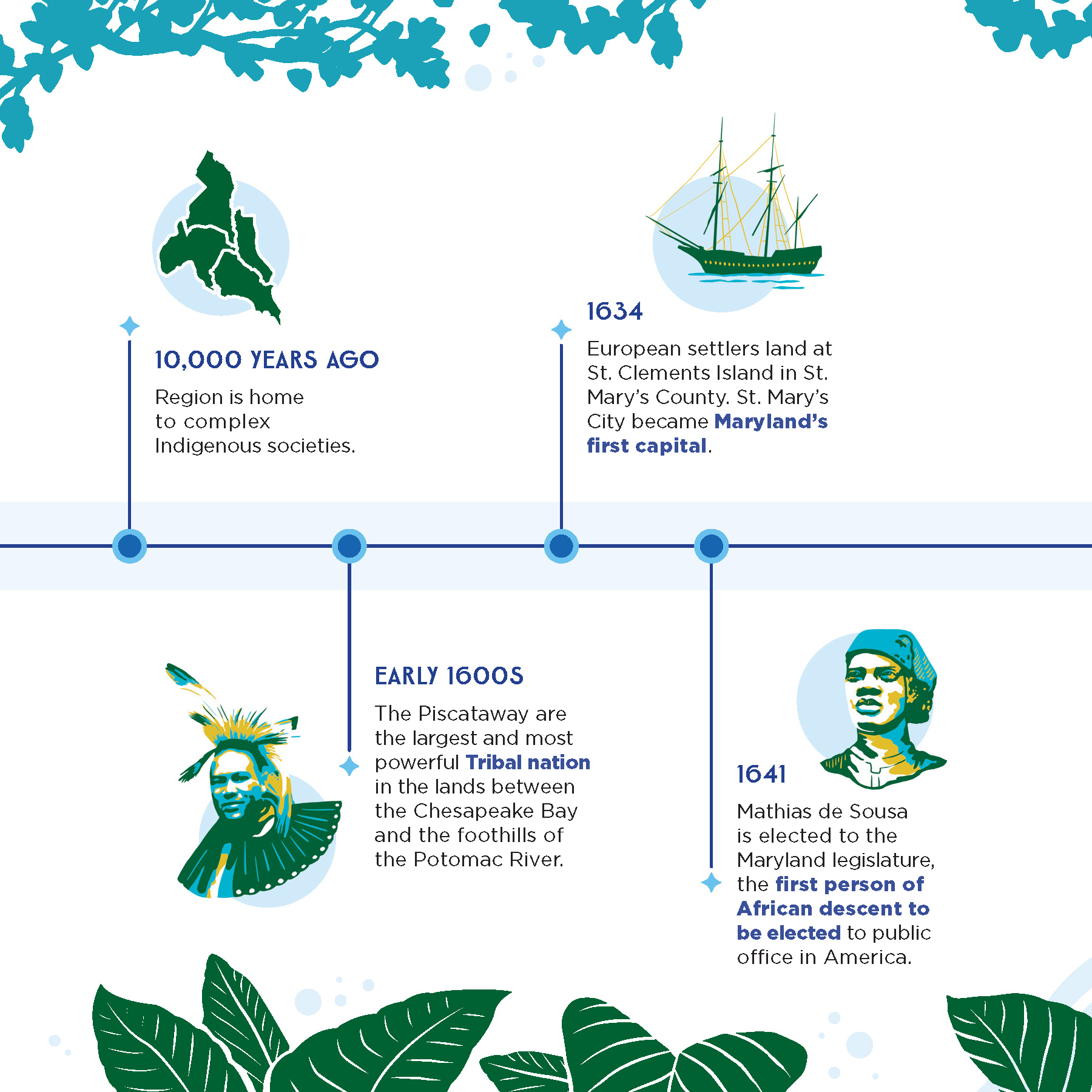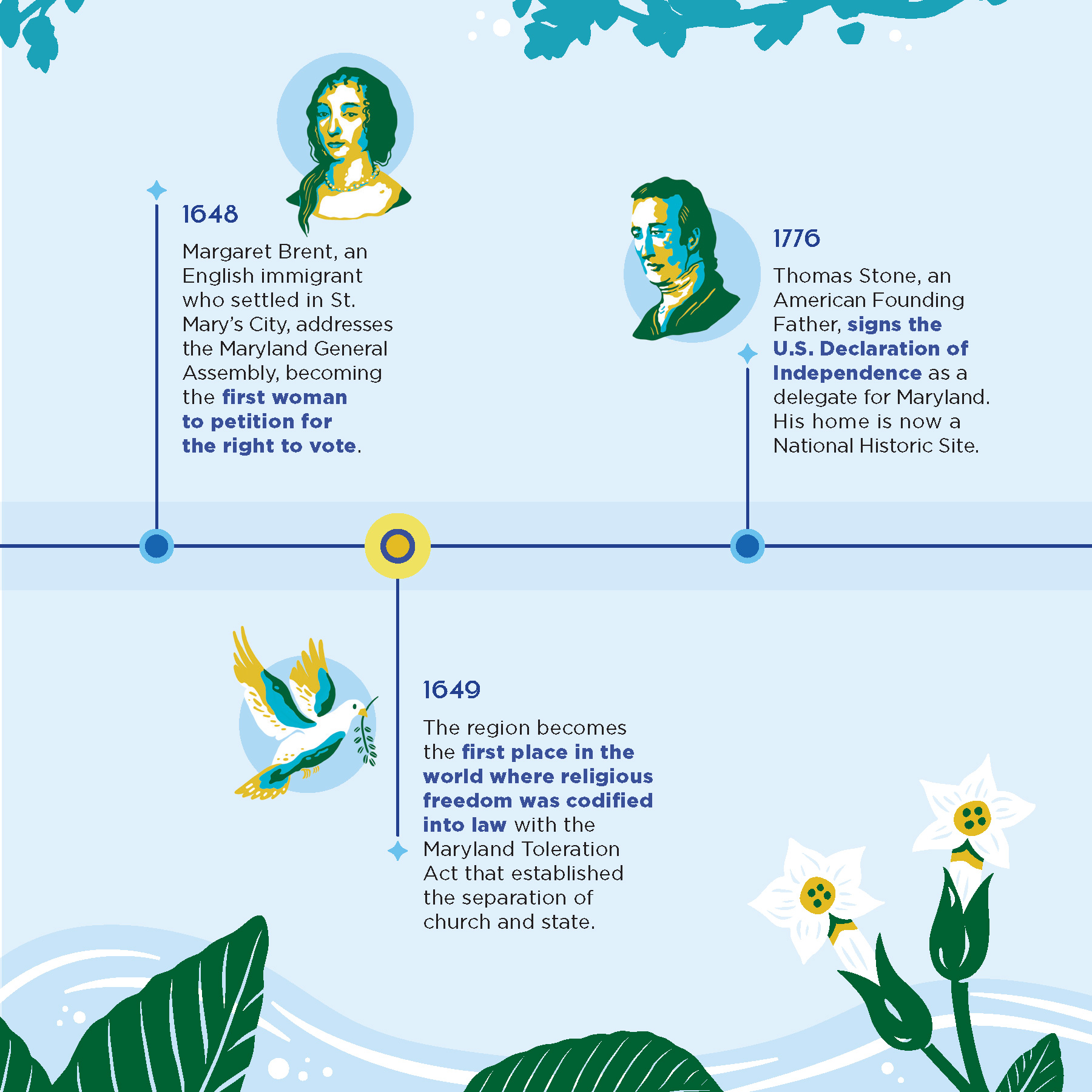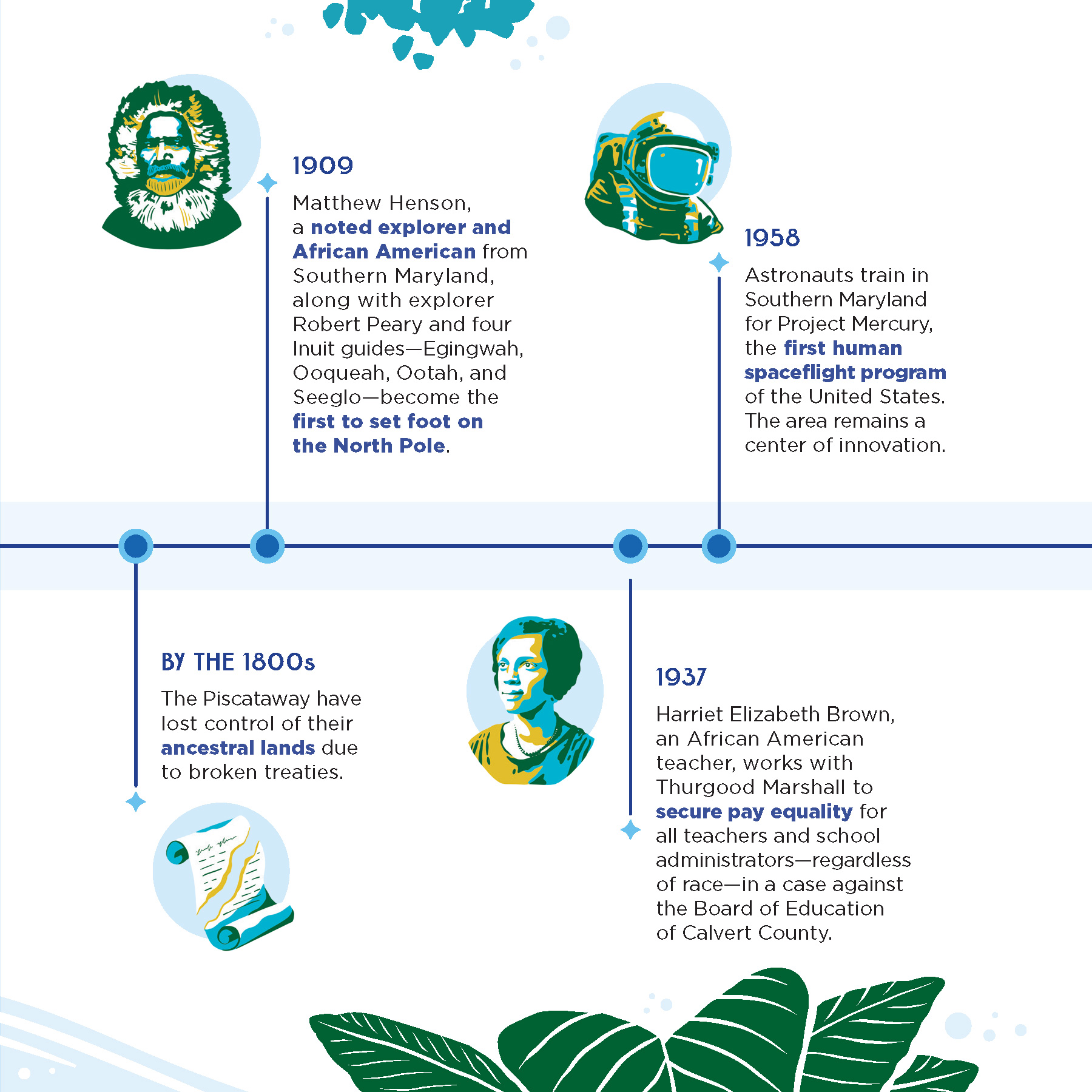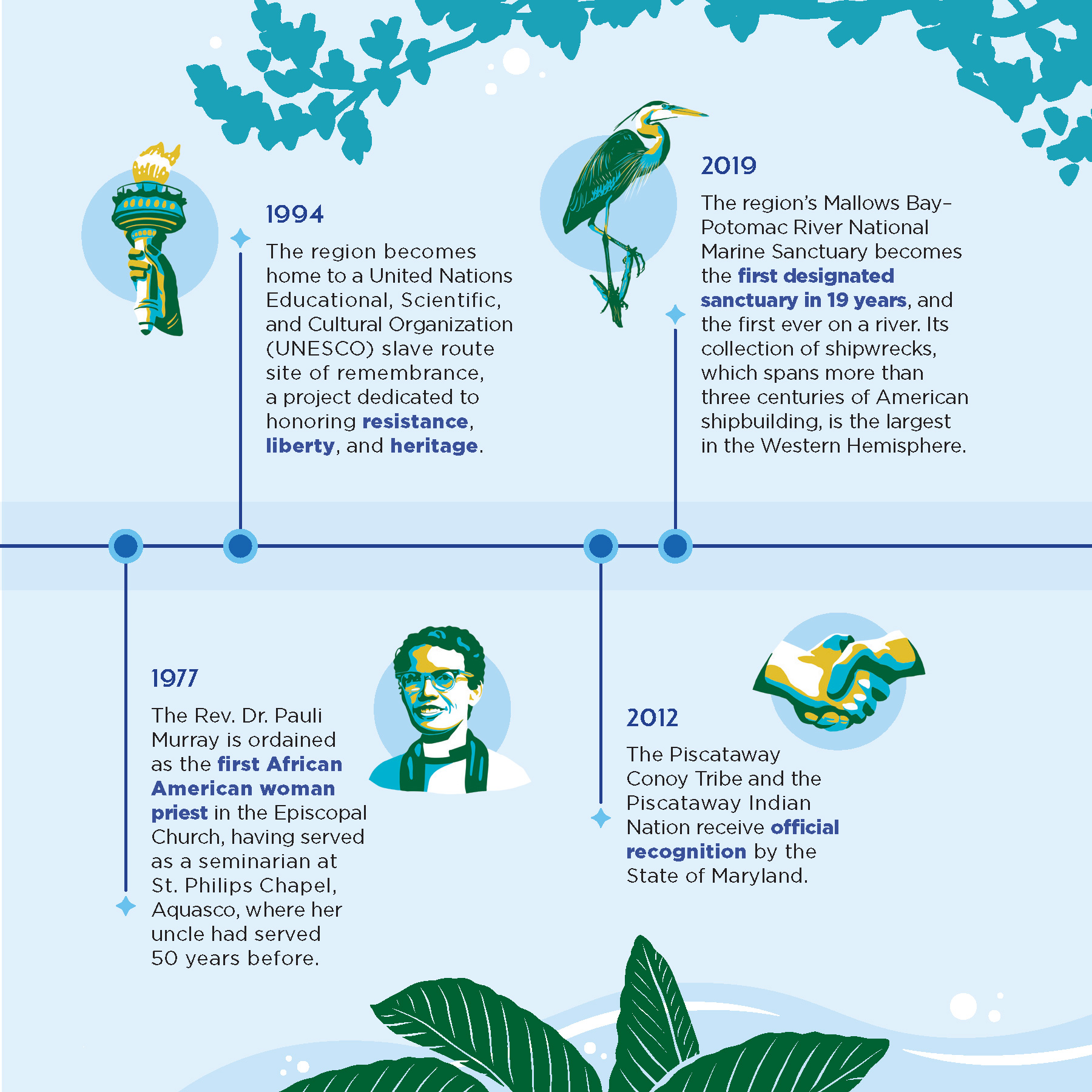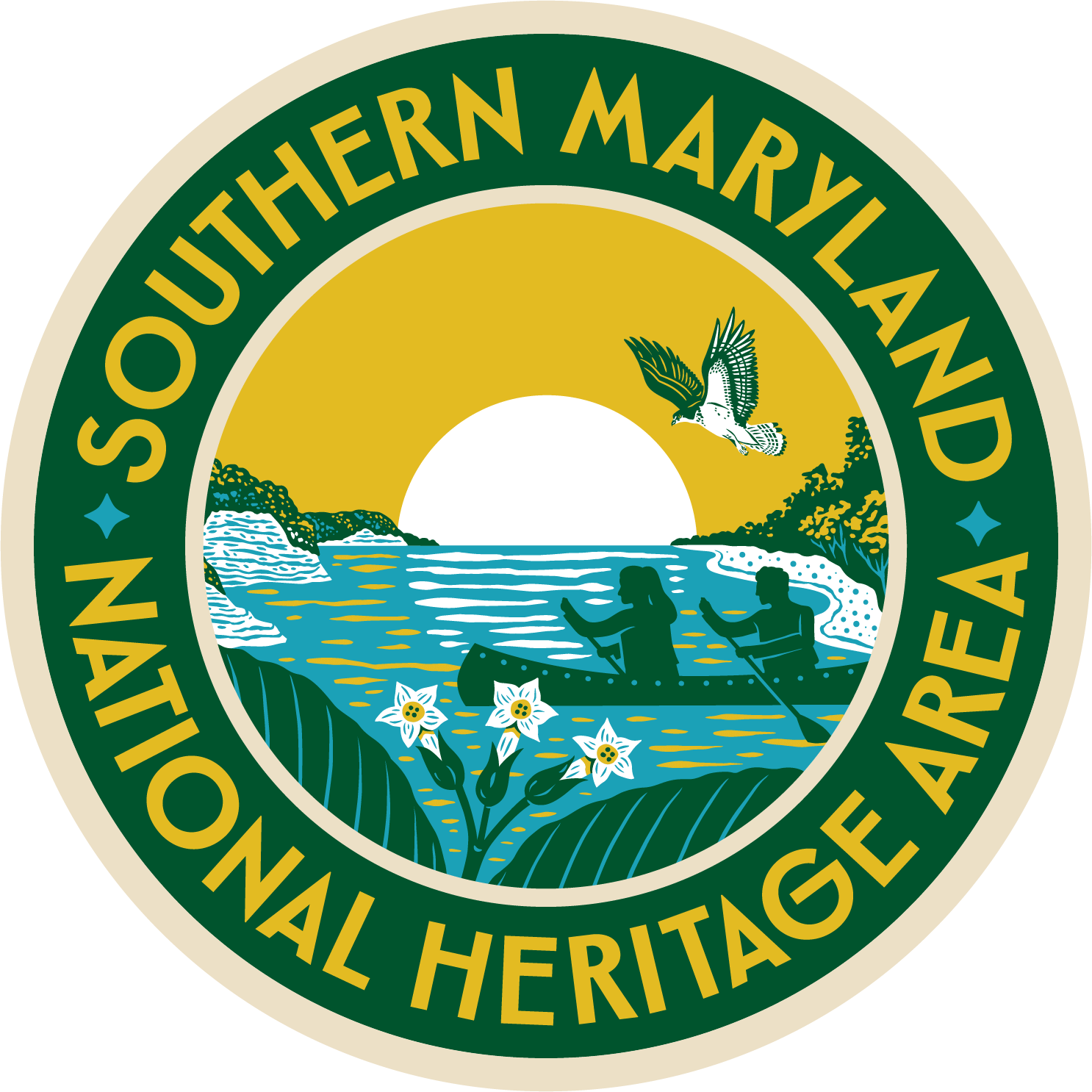
Where Maryland Began

Where Maryland Began
did you know...
Southern Maryland is where Maryland began!
did you know...
Southern Maryland is where Maryland began!
On March 25, 1634, the English ships, the Ark and Dove arrived with settlers (a carefully selected group of Catholics and Protestants) and landed at St. Clements Island in St. Mary’s County, marking Maryland’s beginning. On this island, the first Roman Catholic Mass in the English-speaking colonies was celebrated.
After the purchase of land from the Yaocomaco tribe (a related tribe to the Piscataway), St. Mary’s City was established as the first capital of Maryland. It should be noted that the arrival of Europeans eventually had a severe impact on the Indigenous culture and population as settlement expanded.
On March 25, 1634, the English ships, the Ark and Dove arrived with settlers (a carefully selected group of Catholics and Protestants) and landed at St. Clements Island in St. Mary’s County, marking Maryland’s beginning. On this island, the first Roman Catholic Mass in the English-speaking colonies was celebrated.
After the purchase of land from the Yaocomaco tribe (a related tribe to the Piscataway), St. Mary’s City was established as the first capital of Maryland. It should be noted that the arrival of Europeans eventually had a severe impact on the Indigenous culture and population as settlement expanded.
How Maryland Became Maryland
In 1632, King Charles I of England granted a charter to George Calvert, the first Lord Baltimore, yielding him proprietary rights to a region east of the Potomac River in exchange for a share of the income derived from the land. The territory was named Maryland in honor of Henrietta Maria, the queen consort of Charles I. Before settlement began, George Calvert died and was succeeded by his son Cecilius, who sought to establish Maryland as a haven for Roman Catholics persecuted in England.
How Maryland Became Maryland
In 1632, King Charles I of England granted a charter to George Calvert, the first Lord Baltimore, yielding him proprietary rights to a region east of the Potomac River in exchange for a share of the income derived from the land. The territory was named Maryland in honor of Henrietta Maria, the queen consort of Charles I. Before settlement began, George Calvert died and was succeeded by his son Cecilius, who sought to establish Maryland as a haven for Roman Catholics persecuted in England.
How Maryland Became Maryland
It was in 1632, King Charles I of England granted a charter to George Calvert, the first Lord Baltimore, yielding him proprietary rights to a region east of the Potomac River in exchange for a share of the income derived from the land. The territory was named Maryland in honor of Henrietta Maria, the queen consort of Charles I. Before settlement began, George Calvert died and was succeeded by his son Cecilius, who sought to establish Maryland as a haven for Roman Catholics persecuted in England.
southern maryland is
a Land of Firsts
- The first time that Religious Freedom was codified into law in the Western World. 1649: Act Concerning Religion—the first statute passed by any legislative body of any government in the Western World to guarantee religious liberty. Specifically, the bill, now usually referred to as the Toleration Act, granted freedom of conscience and was the foundation for Religious Freedom in the United States Constitution.
- The first person of African descent to serve in a legislative body in America, and the first to exercise the right to vote. Mathias de Sousa, one of the original colonists, served in the 1642 legislative assembly of freemen.
- The first woman to petition for the right to vote in America. Margaret Brent arrived in the new colony with her sister establishing their own farm: “Sisters Freehold.” On June 24, 1648 she petitioned the assembly for the right to vote. Although she was denied, Margaret Brent is known as the very first suffragette.
You can visit these sites today! Historic St. Mary’s City is an exciting living museum where you can meet an original settler, chat with an indentured servant, witness the ongoing archeology, walk in the path of the founders, and celebrate the Indigenous culture of the region. At St. Clements Island Museum you can take a boat out to the island where the settlers first stepped foot on what is now Maryland.
southern maryland is
a Land of Firsts
- The first time that Religious Freedom was codified into law in the Western World. 1649: Act Concerning Religion—the first statute passed by any legislative body of any government in the Western World to guarantee religious liberty. Specifically, the bill, now usually referred to as the Toleration Act, granted freedom of conscience and was the foundation for Religious Freedom in the United States Constitution.
You can visit these sites today! Historic St. Mary’s City is an exciting living museum where you can meet an original settler, chat with an indentured servant, witness the ongoing archeology, walk in the path of the founders, and celebrate the Indigenous culture of the region. At St. Clements Island Museum you can take a boat out to the island where the settlers first stepped foot on what is now Maryland.
THE FORMATION OF A STATE
Maryland began on St. Clement’s Island and in St. Mary’s City. From the founding of Maryland in 1634, St. Mary’s City was the first seat of Maryland’s colonial government. As the population of Maryland grew, however, St. Mary’s City proved too distant for most of the colony’s inhabitants. Consequently, in 1694, the General Assembly designated Anne Arundel Town, midway up Chesapeake Bay, as the new capital and, in February 1694/5, the government moved its records and its operations there (later renamed Annapolis).
There are a number of other early American sites to visit in Southern Maryland, including:
THE FORMATION OF A STATE
There are a number of other early American sites to visit in Southern Maryland, including:
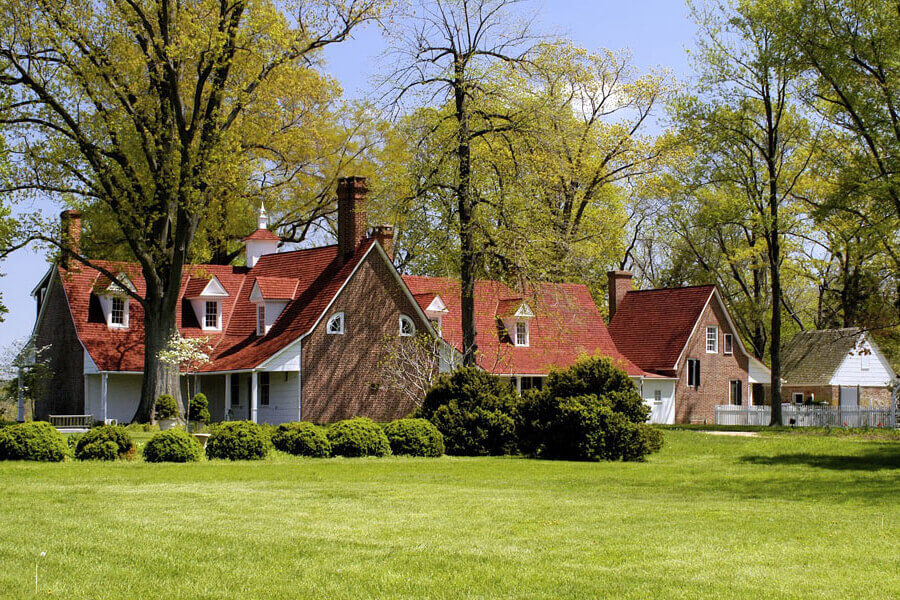
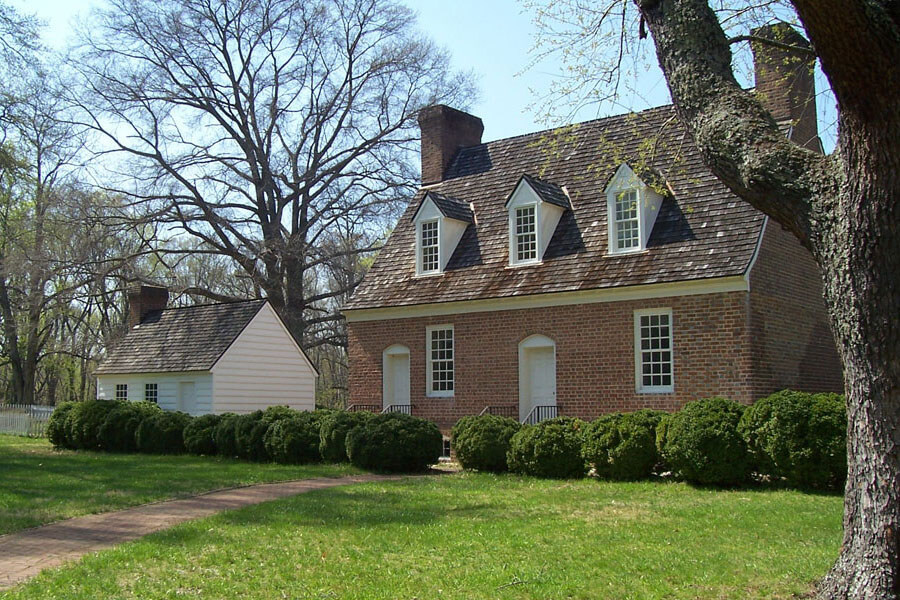

Circa 1703.
Historic Sotterley plantation is set in the beautiful countryside of St. Mary’s County, on the banks of the Patuxent River. Sotterley has built itself into a premier location for exploring the complicated past of the region. This unique historic setting has transformed its mission into one of inclusion and exploration. Sotterley Mission Statement: “To preserve our historic structures and natural environment and use the powerful stories of our land, lives, and labor to bring American history to life while serving as an educational and cultural resource.”

Circa 1732-1792.
The Smallwood Retreat House, originally known as Mattawoman Plantation, was the home of American Revolutionary War General William Smallwood, until his death in 1792. During the Revolutionary War, General Smallwood, a two-star general, was the highest-ranking military man from the State of Maryland. No stranger to positions of leadership, he served three one-year terms as the Governor of Maryland beginning in 1785. A lifelong bachelor, Smallwood was a gentleman farmer, who made a sizeable fortune farming tobacco in Southern Maryland.

Circa 1727.
Near La Plata in Charles County, Port Tobacco was once the second largest city and deep-water port in Maryland, importing goods from Europe and exporting hogsheads of tobacco. Port Tobacco is the smallest incorporated town in Maryland; only 15 people lived there in 2010. The town was established in 1727 and in the following years became the second largest city in Maryland and also the county seat of Charles County. Tidal forces later cut off access to the Chesapeake Bay and the seat of county government moved to La Plata in 1895. You can visit this small jewel of a town, and don’t miss the historic courthouse!
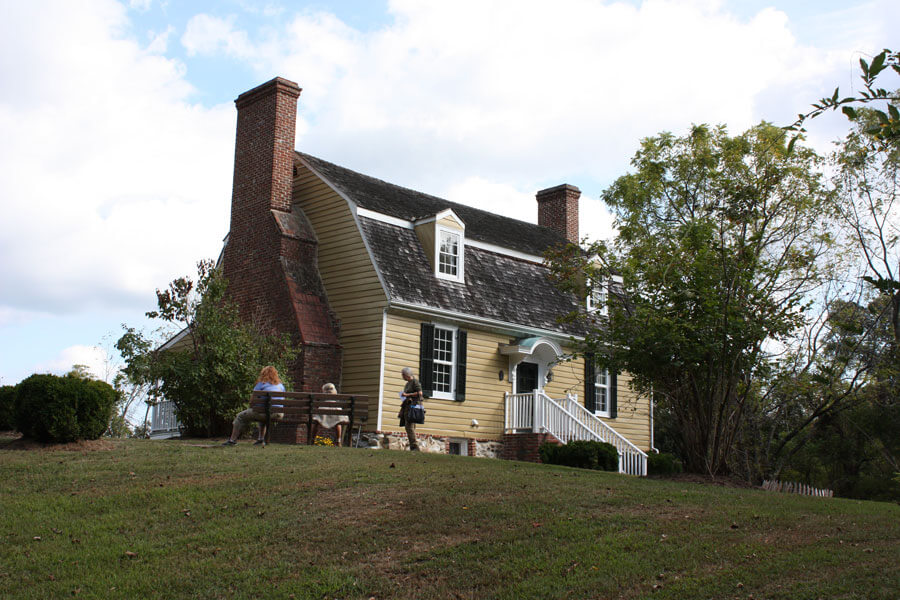
Circa 1768.
Built by merchant and tobacco farmer George Maxwell, Maxwell Hall features massive twin chimneys and foundation stones of English chert. Local tradition holds that in the War of 1812, the British invasion force took possession of Maxwell Hall during their march on Washington in August 1814. Maxwell Hall is one of Southern Maryland’s best surviving examples of a typical 18th century four-over-four room house. This property offers visitors a unique connection to Southern Maryland heritage and a look into Charles County’s role in the War of 1812.


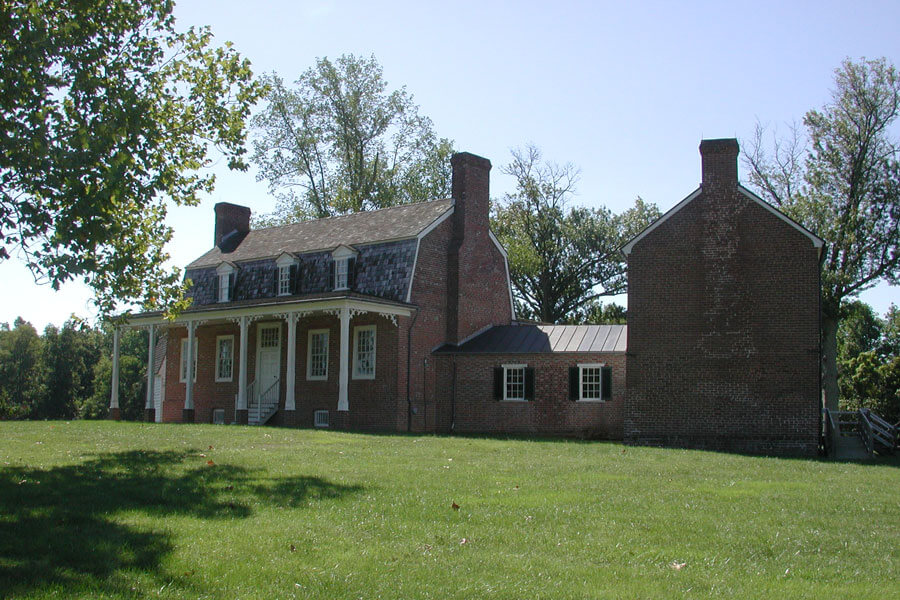
Circa 1771.
Prior to the Revolutionary War, Thomas Stone led a very comfortable life as a planter and lawyer. After realizing war with Great Britain was inevitable, he risked everything he held dear– life, fortune, and honor– to safeguard rights of the new United States of America. To that end, Thomas Stone became one of 56 men to sign The Declaration of Independence. This is a National Park Service site, with a beautifully preserved house and grounds.

Circa 1771.
Prior to the Revolutionary War, Thomas Stone led a very comfortable life as a planter and lawyer. After realizing war with Great Britain was inevitable, he risked everything he held dear– life, fortune, and honor– to safeguard rights of the new United States of America. To that end, Thomas Stone became one of 56 men to sign The Declaration of Independence. This is a National Park Service site, with a beautifully preserved house and grounds.
a timeline of
Southern Maryland's Historical Events
a timeline of
Southern Maryland's Historical Events
